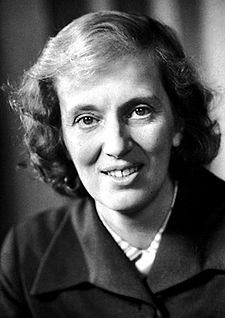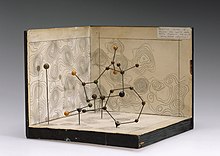Dorothy Hodgkin
From Wikipedia, the free encyclopedia
| Dorothy Hodgkin | |
|---|---|

Dorothy Hodgkin
|
|
| Born | Dorothy Mary Crowfoot 12 May 1910 Cairo, Egypt |
| Died | 29 July 1994 (aged 84) Ilmington, Warwickshire, England |
| Residence | British |
| Nationality | British |
| Fields | Biochemistry |
| Alma mater | University of Oxford |
| Doctoral advisor | John Desmond Bernal |
| Doctoral students | |
| Other notable students | Margaret Thatcher |
| Known for |
|
| Notable awards |
|
She advanced the technique of X-ray crystallography, a method used to determine the three-dimensional structures of biomolecules. Among her most influential discoveries are the confirmation of the structure of penicillin that Ernst Boris Chain and Edward Abraham had previously surmised, and then the structure of vitamin B12, for which she became the third woman to win the Nobel Prize in Chemistry.[8]
In 1969, after 35 years of work and five years after winning the Nobel Prize, Hodgkin was able to decipher the structure of insulin. X-ray crystallography became a widely used tool and was critical in later determining the structures of many biological molecules where knowledge of structure is critical to an understanding of function. She is regarded as one of the pioneer scientists in the field of X-ray crystallography studies of biomolecules. Hodgkin published as Dorothy Crowfoot until 1949, when she was persuaded by Hans Clarke’s secretary to use her married name on her chapter in The Chemistry of Penicillin. Thereafter she always published as Dorothy Crowfoot Hodgkin.
Contents
Early life
Dorothy Mary Crowfoot was born on 12 May 1910 in Cairo, Egypt, to John Winter Crowfoot (1873–1959), an archaeologist and classical scholar, and Grace Mary Crowfoot née Hood (1877–1957), an archaeologist and expert on Ancient Egyptian textiles. She lived in the English expatriate community in Egypt, returning to England only a few months each year. During one of those stays, when Hodgkin was four, World War I began. Her mother lost four brothers in the war.[9] Separated from her parents, who would return to Egypt, she was left under the care of relatives and friends until after the end of the war when her mother came to England for one year, a period that she later described as the happiest in her life.In 1921, she entered the Sir John Leman Grammar School in Beccles. Only once, when she was thirteen, did she make an extended visit to her parents, who by then had moved to Khartoum, although both parents continued to visit England each summer.
Education and research
She developed a passion for chemistry from a young age, and her mother fostered her interest in science in general. Her state school education left her without Latin or a further science subject, but she took private tuition in order to enter the University of Oxford entrance examination. At the age of 18 she started studying chemistry at the University of Oxford (Somerville College, Oxford).[10]
Molecular Structure of vitamin B12, discovered by Dorothy Hodgkin
In 1933 she was awarded a research fellowship by Somerville College, and in 1934, she moved back to Oxford. The college appointed her its first fellow and tutor in chemistry in 1936, a post which she held until 1977. In the 1940s, one of her students was Margaret Roberts, the future Prime Minister Margaret Thatcher,[13] who installed a portrait of Hodgkin in Downing Street in the 1980s.[10]
Together with Sydney Brenner, Jack Dunitz, Leslie Orgel, and Beryl M. Oughton, she was one of the first people in April 1953 to travel from Oxford to Cambridge to see the model of the structure of DNA, constructed by Francis Crick and James Watson, based on data acquired by Rosalind Franklin. According to the late Dr. Beryl Oughton, later Rimmer, they all travelled together in two cars once Dorothy Hodgkin announced to them that they were off to Cambridge to see the model of the structure of DNA.
In 1960, she was appointed the Royal Society's Wolfson Research Professor, a position she held until 1970.[8] This provided her salary, research expenses and research assistance to continue her work at the University of Oxford.
Discoveries
Hodgkin is particularly noted for discovering three-dimensional biomolecular structures.[3] In 1945, working with C. H. (Harry) Carlisle, she published the first such structure of a steroid, cholesteryl iodide (having worked with cholesteryls since the days of her doctoral studies).[14] In 1945, she and her colleagues solved the structure of penicillin, demonstrating (contrary to scientific opinion at the time) that it contains a β-lactam ring. However, the work was not published until 1949.[15] In 1954 she and colleagues began to publish their analysis of vitamin B12.[16][17]Insulin structure
Insulin was one of her most extraordinary research projects. It began in 1934 when she was offered a small sample of crystalline insulin by Robert Robinson. The hormone captured her imagination because of the intricate and wide-ranging effect it has in the body. However, at this stage X-ray crystallography had not been developed far enough to cope with the complexity of the insulin molecule. She and others spent many years improving the technique. Larger and more complex molecules were being tackled until in 1969 – 35 years later – the structure of insulin was finally resolved.[18] But her quest was not finished then. She cooperated with other laboratories active in insulin research, gave advice, and travelled the world giving talks about insulin and its importance for diabetes.Social and personal life
Hodgkin's scientific mentor Professor John Desmond Bernal greatly influenced her life both scientifically and politically. He was a distinguished scientist of great repute in the scientific world, a member of the Communist party, and a faithful supporter of successive Soviet regimes until their invasion of Hungary. She always referred to him as "Sage"; intermittently, they were lovers. The conventional marriages of both Bernal and Hodgkin were far from smooth.[19]In 1937, Dorothy married Thomas Lionel Hodgkin, then recently returned from working for the Colonial Office and moving into adult education.[20] He later became a well-known Oxford lecturer, author of several fundamental Africanist books and a one-time member of the Communist Party.[citation needed] She always consulted him concerning important problems and decisions.[citation needed] In 1961 Thomas became an advisor to Kwame Nkrumah, President of Ghana, in whose country he remained for extended periods, and where she often visited him. Because of her political activity and her husband's association with the Communist Party, she was banned from entering the US in 1953 and subsequently not allowed to visit the country except by CIA waiver.[citation needed] The couple had three children: Luke (born 1938), Elizabeth (born 1941) and Toby (born 1946).
At the age of 24, Hodgkin began experiencing pain in her hands. A visit to a doctor led to a diagnosis of rheumatoid arthritis which would become progressively worse and crippling over time with deformities in both her hands and feet. Eventually, Hodgkin spent a great deal of time in a wheelchair but remained scientifically active despite her disability.[21]
Despite her scientific specialisation, she was also concerned about social inequalities and stopping conflict. As a consequence she was President of Pugwash from 1976 to 1988.[22] However, Hodgkin also retains some infamy for having written the foreword to the 1983 English edition of Stereospecific Polymerization of Isoprene, a scientific paper which carried the authorship of Elena Ceausescu, the wife of the communist dictator of Romania at the time. In the foreword, Hodgkin speaks glowingly of Ceausescu's "outstanding achievements" and "impressive" career.[23] After the Romanian Revolution of 1989, it was widely revealed that Ceausescu never finished secondary school, never attended university, that her scientific credentials were a hoax, and the publication in question – like all the research published under her name throughout her life – was written by a team of scientists in her name in order to obtain a fraudulent doctorate to advance her international prestige as a communist political figure.[24]
On July 29, 1994, Hodgkin died due to cardiac stroke at her home in Warwickshire.[8]
Honours

Order of Merit medal of Dorothy Hodgkin, displayed in the Royal Society, London.
In 1983, Hodgkin received the Austrian Decoration for Science and Art.[26]
Cultural references
The Royal Society has established the prestigious Dorothy Hodgkin fellowship for early career stage researchers.Dorothy Hodgkin was one of five 'Women of Achievement' selected for a set of British stamps issued in August 1996. The others were Marea Hartman (sports administrator), Margot Fonteyn (ballerina/choreographer), Elisabeth Frink (sculptor) & Daphne du Maurier (writer). All except Hodgkin were Dames Commander of the Order of the British Empire (DBEs). In 2010, during its 350th anniversary, the Royal Society celebrated with the publication of 10 stamps of some of its most illustrious members, bestowing Professor Hodgkin with her second stamp. She was in the company of nine men: Isaac Newton, Edward Jenner, Joseph Lister, Benjamin Franklin, Charles Babbage, Robert Boyle, Ernest Rutherford, Nicholas Shackleton and Alfred Russel Wallace.[27]
Council offices in the London Borough of Hackney and buildings at King's College London, University of York, Bristol University and Keele University are named after her, as is the science block at Sir John Leman High School, her former school.
On 12 May 2014, the 104th anniversary of Hodgkin's birthday was commemorated by a Google Doodle.[28]
Dorothy Hodgkin Memorial Lecture
An annual memorial lecture is held every March in honour of Hodgkin's work; past speakers have included:- Professor Louise Johnson, "Dorothy Hodgkin and penicillin", 4 March 1999.
- Professor Judith Howard, "The Interface of Chemistry and Biology Increasingly in Focus", *13 March 2000.
- Professor Jenny Glusker, "Vitamin B12 and Dorothy: Their impact on structural science", 15 May 2001.
- Professor Pauline Harrison CBE, From Crystallography to Metals, Metabolism and Medicine, 5 March 2002.
- Dr Claire Naylor, Pathogenic Proteins : how bacterial agents cause disease, 4 March 2003.
- Dr Margaret Adams, "A Piece in the Jigsaw: G6PD – The protein behind an hereditary disease", 9 March 2004.
- Dr. Margaret Rayman, "Selenium in cancer prevention", 10 March 2005.
- Dr Elena Conti, "Making sense of nonsense: structural studies of RNA degradation and disease", 9 March 2006.
- Professor Jenny Martin, "The name's Bond – Disulphide Bond", 6 March 2007.
- Professor E. Yvonne Jones, "Postcards from the surface: The Structural Biology of Cell-Cell Communication", 4 March 2008.
- Professor Pamela J. Bjorkman, "Your mother's antibodies: How you get them and how we might improve them to combat HIV", 11 March 2009.
- Professor Elspeth Garman, "Crystallography 100 years A.D (After Dorothy)" 9 March 2010.
- Professor Eleanor Dodson, "Mathematics in the service of Crystallography" 10 March 2011.
- Professor Sir Venkatraman Ramakrishnan, "How antibiotics illuminate ribosome function and vice versa" March 2012.
- Professor Susan Lea, "Bacterial secretion systems – using structure to build towards new therapeutic opportunities", 5 March 2013.
- Professor Carol V. Robinson, "Finding the Right Balance", 11 March 2014


No comments:
Post a Comment
Please leave a comment-- or suggestions, particularly of topics and places you'd like to see covered